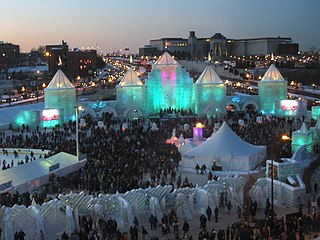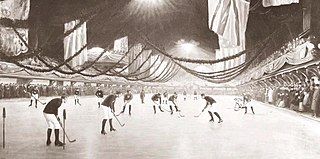
Winter sports or winter activities are competitive sports or non-competitive recreational activities which are played on snow or ice. Most are variations of skiing, ice skating and sledding. Traditionally, such games were only played in cold areas during winter, but artificial snow and artificial ice allow more flexibility. Playing areas and fields consist of either snow or ice.

Bobsleigh or bobsled is a team winter sport that involves making timed runs down narrow, twisting, banked, iced tracks in a gravity-powered sleigh. International bobsleigh competitions are governed by the International Bobsleigh and Skeleton Federation, also known as FIBT from the French Fédération Internationale de Bobsleigh et de Tobogganing. National competitions are often governed by bodies such as the United States Bobsled and Skeleton Federation and Bobsleigh Canada Skeleton.

Snowshoes are specialized outdoor gear for walking over snow. Their large footprint spreads the user’s weight out and allows them to travel largely on top of rather than through snow. Adjustable bindings attach them to appropriate winter footwear.

Mount Royal is a large intrusive rock hill or small mountain in the city of Montreal, immediately west of Downtown Montreal, Quebec, Canada. The best-known hypothesis for the origin of the name Montreal is that the name is taken from Mount Royal.

Sledding, sledging or sleighing is a winter sport typically carried out in a prone or seated position on a vehicle generically known as a sled, a sledge (British), or a sleigh. It is the basis of three Olympic sports: luge, skeleton and bobsledding. When practised on sand, it is known as a form of sandboarding. In Russia sledges are used for maritime activities including fishing and commuting from island to island on ice.

A toboggan is a simple sled traditionally used by children. It is also a traditional form of transport used by the Innu and Cree of northern Canada.
The Amateur Hockey Association of Canada (AHAC) was an amateur men's ice hockey league founded on 8 December 1886, in existence until 1898. It was the second ice hockey league organized in Canada, after one in Kingston, Ontario started in 1883. It was organized to provide a longer season to determine the Canadian champion. Prior to its founding, the Canadian championship was determined in a tournament in Montreal. It is the first championship ice hockey league.

The Quebec Winter Carnival, commonly known in both English and French as Carnaval, is a pre-Lenten festival held in Quebec City. After being held intermittently since 1894, the Carnaval de Québec has been celebrated annually since 1955. That year, Bonhomme Carnaval, the mascot of the festival, made his first appearance. Up to one million people attended the Carnaval de Québec in 2006 making it, at the time, the largest winter festival in the world. It is, however, the largest winter festival in the Western Hemisphere.

Montreal Amateur Athletic Association is Canada's oldest athletic association, located in Montreal, Quebec. It was renamed as the Club Sportif MAA or just MAA in 1999 after a brush with bankruptcy, but is still widely known as the MAAA. In the late 19th and early 20th centuries, the MAA was one of the most important sporting institutions in Canada, and North America, with affiliated teams winning ice hockey's Stanley Cup and Canadian football's Grey Cup.

The Montreal Crystals were an ice hockey team based in Montreal, Quebec, Canada that existed from 1884 to 1895. One of the first established ice hockey teams, the Crystals played various challenges against other clubs in the early days of ice hockey competition. They won the Canadian championship in 1886, defeating Quebec, which withdrew due to numerous injuries in the final game. Later that year the Crystals helped to found the Amateur Hockey Association of Canada where they played the first five seasons. The club won the championship in 1887, defeating the Montreal Victorias in the last challenge of the season. The team played further challenges for the championship from 1888 to 1891. For the 1890 season, the club became known as the Montreal Dominions. In 1891 they became known as the Montreal Crescents. The team sat out the 1892 season. In 1893 they returned to the league and returned to their original name of Montreal Crystals.
An ice palace or ice castle is a castle-like structure made of blocks of ice. These blocks are usually harvested from nearby rivers or lakes when they become frozen in winter. The first known ice palace appeared in St. Petersburg, Russia, and was the handiwork of Empress Anna. Anna Ivanovna, Empress of Russia, commissioned an ice palace in St. Petersburg, Russia, during the winter of 1739–40. Architect Piotr Eropkin and scientist Georg Wolfgang Krafft used huge ice blocks measuring 16 m (52 ft) long by 5 m (16 ft) wide, joined together with frozen water, to build the palace. The city recreates the ice palace every winter.

The Saint Paul Winter Carnival is an annual festival in Saint Paul, Minnesota, United States.

The Harbin International Ice and Snow festival is an annual winter festival that takes place with a theme in Harbin, Heilongjiang, China, and now is the largest ice and snow festival in the world. At first participants in the festival were mainly Chinese, however it has since become an international festival and competition, with the 2018 festival attracting 18 million visitors and generating 28.7 billion yuan of revenue. The festival includes the world's biggest ice sculptures.

The Victoria Skating Rink was an indoor ice skating rink located in Montreal, Quebec, Canada. Opened in 1862, it was described at the start of the twentieth century to be "one of the finest covered rinks in the world". The building was used during winter seasons for pleasure skating, ice hockey and skating sports on a natural ice rink. In summer months, the building was used for various events, including musical performances and horticultural shows. It was the first building in Canada to be electrified.

On March 3, 1875, the first recorded indoor ice hockey game took place at the Victoria Skating Rink in Montreal, Quebec, Canada. Organized by James Creighton, who captained one of the teams, the game was between two nine-member teams, using a wooden "puck". Members used skates and sticks used for outdoor hockey and shinny games in Nova Scotia, where Creighton was born and raised. It is recognized as the first organized ice hockey game.

The Montreal Winter Carnival Ice Hockey Tournaments were a series of annual ice hockey tournaments held in the 1880s in conjunction with the Montreal Winter Carnival, in Montreal, Quebec, Canada. First held in 1883, these tournaments are considered to be the first championship ice hockey tournaments and the predecessor to the first championship ice hockey league, the Amateur Hockey Association of Canada.
The Montreal Snow Shoe Club (MSSC) was a sports club in Montreal, Quebec, Canada. Founded in 1840 by twelve well-known young men, it was the first club of its sort in North America and led the way for hundreds of other clubs like it to be established across Canada and the United States. Though as a club the MSSC was significantly pre-dated by others such as the Royal Montreal Curling Club and the Montreal Hunt, it was snowshoeing that pioneered the organization of sport in Montreal. In the 19th century, only lacrosse exceeded the total number of urban snowshoe clubs in Canada. In the period before 1867, Lindsay remarks, "a history of snowshoeing in Canada is virtually a history of snowshoeing in Montreal, and, in particular, the Montreal Snow Shoe Club". The MSSC laid the foundations for many other winter and sporting clubs to be established in Montreal, and notably the world's first Winter Carnival.
The history of Canadian sports falls into five stages of development: early recreational activities before 1840; the start of organized competition, 1840–1880; the emergence of national organizations, 1882–1914; the rapid growth of both amateur and professional sports, 1914 to 1960; and developments of the last half-century. Some sports, especially hockey, lacrosse and curling enjoy an international reputation as particularly Canadian.

Ice hockey, simply referred to as hockey in both English and French in Canada, dates back to the 19th century. The sport is very popular and played year-round and at every level in the country. Born of various influences from stick-and-ball games brought from the United Kingdom and indigenous games, the contemporary sport of ice hockey originated in Montreal. It is the official national winter sport of Canada and is widely considered Canada's national pastime, with high levels of participation by children, men and women at various levels of competition.

William Rowen Granger was a Canadian sports administrator and businessman. He served as president of the Montreal AAA from 1918 to 1920, oversaw the revival of the association's ice hockey, baseball and soccer teams after World War I, and previously served as president of the Montreal Lawn Bowling Club and the Montreal Bicycle Club. He helped establish the Province of Quebec Lawn Bowling Association and became its president in 1919. He also served as president of the Inter-Club Road Race Association of Montreal, helped organize the Cyclists' Rights Committee in Montreal, and was a director of the Canadian Wheelmen's Association. He was instrumental in founding the Quebec Amateur Hockey Association (QAHA) in 1919, and became its second president. He was committed to amateurism in sport, sought to rid hockey of veiled professionalism, and implemented standard rules of play and registration cards with the Amateur Athletic Union of Canada. Granger and the QAHA were defendants in a court case that challenged the denial of an amateur registration card to a player who participated in semi-professional baseball prior to reaching the age of majority. The case necessitated constitutional changes to the strengthen the QAHA's authority and that registration forms be printed in both English and French.
















